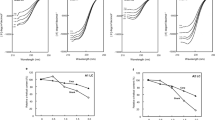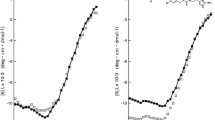Abstract
Elasmobranchs, such as sharks, retain large amounts of urea in their body, but shark muscle proteins are not denatured by urea in vivo. There are two hypotheses regarding biosystems in the quenching of urea. One is that the accumulation of large amounts of trimethylamine-N-oxide suppresses protein denaturation by urea, and the other is that shark muscle proteins have an intrinsic resistance to urea. We focused on a protective effect of adenosine triphosphate (ATP) on fish muscle proteins, and studied the suppressive effect of ATP on urea denaturation of myosin Ca-ATPase from the scalloped hammerhead shark, Sphyrna lewini. Regarding myosin incubated with both ATP and urea, Ca-ATPase activity was higher than for that incubated with urea. The inactivation of Ca-ATPase activity induced by urea in the presence of ATP proceeded in two phases: a slow first-order reaction in an early phase and a fast first-order reaction in a late phase. The late phase seemed to start at the time when the remaining ATP had been depleted in the medium. These results suggest that ATP suppressed the denaturation of myosin Ca-ATPase by urea. ATP may act in vivo as a safeguard against muscle protein denaturation by urea.







Similar content being viewed by others
References
Arai K, Hasnain A, Takano Y (1976) Species specificity of muscle proteins of fishes against thermal and urea denaturation. Nippon Suisan Gakkaishi 42:687–695
Bonaventure J, Bonaventure C, Sullivan B (1974) Urea tolerance as a molecular adaptation of elasmobranch hemoglobins. Science 186:57–59
Finer EG, Franks F, Tait MJ (1972) Nuclear magnetic resonance studies of aqueous urea solutions. J Am Chem Soc 94:4424–4429
Fuery CJ, Attwood PV, Withers PC, Yancey PH, Baldwin J, Guppy M (1997) Effects of urea on M4-lactate dehydrogenase from elasmobranchs and urea-accumulating Australian desert frogs. Comp Biochem Physiol 117B:143–150
Gomori G (1942) A modification of the colorimetric phosphorus determination for use with a photoelectric colorimeter. J Lab Clin Med 27:955–960
Gornall AG, Bardwill CJ, David MM (1949) Determination of serum proteins by means of the Biuret reaction. J Biol Chem 177:751–766
Inohara K, Kurogi S, Onoue Y, Hamada M, Tamotsu S, Kimura I (2014) Suppressive effect of ATP contained in muscle on the browning of amberjack Seriola dumerili dark muscle during frozen storage. Nippon Suisan Gakkaishi 80:965–972 (in Japanese with English abstract)
Kanoh S, Watabe S, Hashimoto K (1985a) ATPase activity of requiem shark myosin. Nippon Suisan Gakkaishi 51:973–977
Kanoh S, Watabe S, Takewa T, Hashimoto K (1985b) Urea-resistibility of myofibrillar proteins from the requiem shark Triakis scyllia. Nippon Suisan Gakkaishi 51:1713–1716
Kanoh S, Niwa E, Osaka Y, Watabe S (1999) Effects of urea on actin- activated Mg2+-ATPase of requiem shark myosin. Comp Biochem Physiol 122B:333–338
Kanoh S, Taniguchi J, Yamada T, Niwa E (2000) Effect of urea on α-helical structure of requiem shark myosin. Nippon Suisan Gakkaishi 66:882–887 (in Japanese with English abstract)
Laemmli UK (1970) Cleavage of structure proteins during the assembly of the head of bacteriophage T4. Nature 227:680–685
Lin TY, Timasheff SN (1994) Why do some organisms use a urea-methylamine mixture as osmolyte? Biochemistry 33:12695–12701
Lowey S, Holtzer A (1959) The aggregation of myosin. J Am Chem Soc 81:1378–1383
Mackie MI (1966) The effect of adenosine triphosphate, inorganic pyrophosphate and inorganic tripolyphosphate on the stability of cod myosin. Biochim Biophys Acta 115:160–172
Murata Y, Henmi H, Nishioka F (1994) Extractive components in the skeletal muscle from ten different species of scombroid fishes. Fish Sci 60:473–478
Ogata Y, Shindo J, Kimura I (2012) Suppression effect of ATP on freeze denaturation of fish myofibrillar protein. Nippon Suisan Gakkaishi 78:461–467 (in Japanese with English abstract)
Patel A, Malinovska L, Saha S, Wang J, Alberti S, Krishnan Y, Hyman A (2017) ATP as a biological hydrotrope. Science 356:753–756
Rice AM, Rosen MK (2017) ATP controls the crowd. Science 356:701–702
Robertson JD (1989) Osmotic constituents of the blood plasma and parietal muscle of Scyliorhinus canicula (L.). Comp Biochem Physiol 93A:799–805
Takashina H, Kasuya M (1967) Inactivation of myosin A by a low concentration of urea. Arch Biochem Biophys 118:475–487
Watabe S, Ochiai Y, Kanoh S, Hashimoto K (1983) Proximate and protein composition of requiem shark muscle. Nippon Suisan Gakkaishi 49:265–268
Wetlaufer DB, Malik SK, Stoller L, Coffin RT (1964) Nonpolar group participation in the denaturation of proteins by urea and guanidinium salts. Model compound studies. J Am Chem Soc 86:508–514
Yancey PH, Somero G (1979) Counteraction of urea destabilization of protein structure by methylamine osmoregulatory compounds of elasmobranch fishes. Biochem J 183:317–323
Yoshioka T, Arai K (1986) Protective effect of ATP-MgCl2 on thermal denaturation of myosin from rabbit and tilapia muscles. Nippon Suisan Gakkaishi 52:1829–1836 (in Japanese with English abstract)
Yoshioka T, Hamai M, Konno K, Arai K (1991) Re-examination of protective effect of ATP on thermal inactivation of myosin Ca-ATPase. Nippon Suisan Gakkaishi 57:143–147 (in Japanese with English abstract)
Acknowledgments
We would like to thank Associate Professor Sanae Kato (Kagoshima University Faculty of Fisheries) and Professor Emeritus Hiroshi Asai (Waseda University) for discussions regarding this study.
Author information
Authors and Affiliations
Corresponding author
Rights and permissions
About this article
Cite this article
Ogata, Y., Kimura, I. Adenosine triphosphate suppresses urea-induced denaturation of shark myosin calcium adenosine triphosphatase. Fish Sci 85, 227–235 (2019). https://doi.org/10.1007/s12562-018-1264-8
Received:
Accepted:
Published:
Issue Date:
DOI: https://doi.org/10.1007/s12562-018-1264-8




